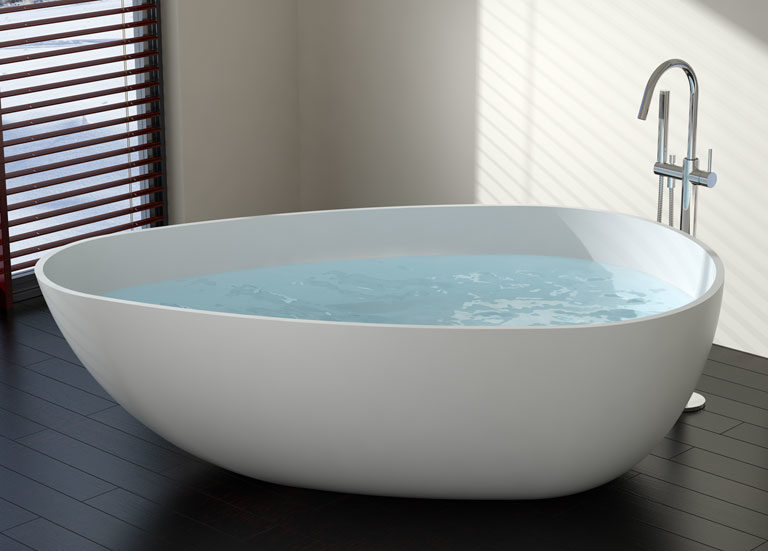Home | What to consider when choosing a bathtub?
How to choose a bathtub for my bathroom?
A bathtub can add a lot of character and color to any bathroom. Replacing an old bathtub can make your bathroom a lot more update and fresh. Here are things to consider before choosing a bathtub;
Bathtub Style, Size, Material, Weight, Price
1- Bathtub Styles
There are afew styles of bathtub to accommodate just about any bathroom size and shapes. The amount of space you have is a huge factor to select the right style.
Freestanding Bathtubs
One of the most popular style of bathtubs are the freestanding. This style can freely fit to any space and doesn’t need any special connection or support. Hence, it’s easy to install in any space. They also tend to be more stylish and modern compared to conventional drop-in bathtubs.
Regular Bathtubs
This classic design bathtubs has been around for more than 200 years. This kind of tubs are usually longer with rectangular shape, and require more space comparing to the alternatives.
Alcove Bathtub
Or sometimes referred to as recessed tubs, are installed in a recess of three connecting walls with one finished side. These bathtubs are generally found in apartments or smaller homes as they don’t take up a lot of space and many can be combined into a shower combo.
Corner bathtub
These tubs are very similar in Alcove tubs, but larger and are placed in corners. Corner tubs are usually similar to hot tubs than normal tubs.
Drop In Bathtub
These kind of bathtubs are installed underneath the surrounding deck or ingress, so it looks more uniform to your bathroom as the rim is hidden. Drop-ins are installed by dropping them in a carved out area then sealed in, so the rim is more visible. Beyond the visual aspects, there isn’t much difference between an undermount and drop-in bathtub. They both save space, they both come in many different styles and material and many of them can be fitted with powered jets for a more relaxing bath experience or combined with a shower for multipurpose use.
Whirlpool
A Whirpool tub is a tub which houses self-contained jets. These jets are either air or water jets, but their primary function is to massage the user for both relaxation and health purposes. Air jet whirlpools contain dozens of small jets that pump warm air through to create air bubbles while water jet whirlpool have fewer but larger jets that push water at high speeds. The primary advantage of a whirlpool tub is that it creates a deeper massage sensation than any other tub on the market.
Soaking Style
Soaking or Japanese tubs are usually oval or circular in shape. With higher edges than a normal tub, people usually sit there for a bit of time, allowing themselves to soak. These kind of tubs come in various sizes and different materials.
2- Bathtub Size
Bathtub Size is an important factor as your home may not need a larger bathtub if a smaller bathtub size can be used. Generally, for freestanding and corner bathtubs, if you have the requisite space, you may choose those styles. But, if your space is more limited, alcove, drop-in, and soaking might be more suitable.
3- Bathtub Materials
Every material feels different to the touch, so you should test out which is the most comfortable to you as you will be spending a significant time in your bathtub and your comfort is important to enjoy it. However, the most comfortable material may also be quite pricey and quite heavy. Let’s talk about the differences and benefits of the materials usually used in tubs.
Fiberglass
This is the cheapest bathtub material of all. Generally, they are very durable, but prone to chipping from hard impacts. They may also absorb water over time and get deformed.
Porcelain
This material is a result of layering cast iron with mixture of powdered glass and heated into a durable coating. This material is very durable and non-porous. The only cons is that it is delicate to heavy impacts.
Acrylic
It is formed by taking a solid sheet of petrochemicals, stabilizers, resin and appropriate dye, heating it then molding the result into a bathtub shape which is then reinforced with fiberglass. Lightweight and available in many styles and sizes, acrylic is a popular choice for both drop-in and freestanding bathtubs. Although it looks and feels quite similar to fiberglass, the material is non-porous, making its durability much higher than fiberglass. It is also resistant to chipping and heavy impacts
Ceramic
Ceramic bathtubs are formed by molding numerous ceramic tiles together until it hardens. These tubs are easy to build and can easily build into different shapes. The drawback to this is that ceramic must be continually maintained or it will eventually deteriorate and crumble.
Stone Resin
Engineered stone or Stone resin is composed of crushed natural stone rounded together with adhesive to give you a composite material. This has the look and feel of natural stone without the additional weight and added cost. A popular choice as it is a solid middle ground between cost and quality, stone resin offers excellent durability and heat retention while also being non-porous and quite affordable. The only limiting factor with stone resin is that there aren’t a lot of style choices compared to other materials on market.
Cultured Marble
Made from crushed limestone and resin, this material is as classic as ancient Rome. It retains heat very well and is quite durable while carrying an excellent pearlescent shine. However, the numerous cons of this material keeps it from being very popular. An expensive material, with a starting price tag of $700, cultured marble is also quite heavy, adding more hassle to install. Finally, if regular maintenance is not kept on cultured marble, it will start to discolor and stain.
Copper
Copper bathtubs are custom made from pure copper and are the cusp of what is considered a luxury bathtub. This material is incredibly durable, holds heat, requires absolutely no additional maintenance other than consistent water use and is aesthetically brilliant. It is also, 2-3x more expensive than any bathtub material on the market.
4- Bathtub Weight
Weight is a crucial factor to consider when purchasing a tub. The weight of your tub will determine where you can place your bathtub. If the material of the tub is too heavy, your floor and house may not be able to support it when it is filled with water. This can be tricky as some of the more quality materials such as Cast Iron, Natural Stone and Copper are highly desirable, but are often too heavy for many homes. A common solution for this problem is to reinforce your floor so that it can handle the increased weight.
5- Price
Price of a bathtub is determined by its material, size and quality. In general, the larger the bathtub, the more expensive it’s going to be. Now let’s talk more about the material here;
Price per Material
On average, Fiberglass tubs are the cheapest. Next on the list would be Acrylic tubs. Then we can place the porcelain tubs but the price for these type can varies largely due to different factors. Generally, Fiberglass, Porcelain and Acrylic tubs are more affordable options on the market ranging anywhere from $500 to $2000.
On the higher end, we have cast iron, steel and cooper. As discussed before, these are very durable and high quality and stylish. However, they tend to get very heavy and might not be suitable for many places.
Price per Style
Style also plays a big factor when shopping for a bathtub. Freestanding tubs are usually more expensive than the other options but they are easier to install. Alcove tubs, on the other hand, are cheaper but they tend to be more costly to install. Drop-ins are somewhere in between and are easier to install than Alcoves. Finally, the corner tubs are the most expensive ones as they come with extra features similar to a hot tub.
For more information you can go to our bathtub section or watch this video.
See related articles
Your feedback is valuable to us
0 Comments


